I have been meaning to get around to posting a full review of my experience attending ATP Flight School for a long time, but have been sidetracked for one reason or another.
Now that I work from home, I have the time to write ridiculously long blog posts such as this one.
It has been 15 years since I attended ATP, so keep in mind that a lot of things may (and probably have) changed since I went there.
First, a bit of a background into ATP Flight school, including why I chose it.
Note: I probably should have mentioned this when I first published this post, but I just wanted to make it clear that I in no way have any affiliation with ATP Flight School.
They didn’t pay me to write this review, ‘mentor’ potential students, or try to convince you to attend their school.
All of the below thoughts are simply from my own personal perspective as a former student.
Jump To A Section
Living Accommodations / Rooming Situation at ATP
What’s The Flying Like At ATP?
What Are The Instructors Like At ATP?
What’s CFI School At ATP Like?
ATP Flight School Crashes (personal story here)
Final Thoughts / Recommendations
1. What is ATP?
ATP is short for Airline Transport Professionals, a private network of 50 flight schools located across the continental US.
If you’ve read AOPA magazine, visited a website like Airline Pilot Central, or did even the slightest amount of research into becoming a pilot, then you’ve probably heard of ATP.
I still get their advertisements on Facebook, and I graduated from their program over 10 years ago!
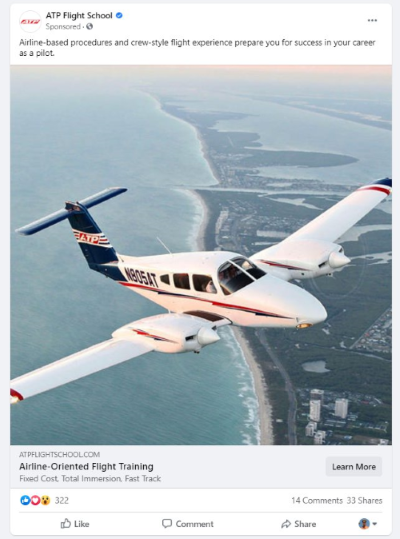
It was founded in 1984, and is one of the largest (if not the largest) flight training academies in the US.
It’s headquartered in Jacksonville, FL, and according to Wikipedia it currently has a fleet of 171 Cessna 172-s, 150 Piper Archers, and 92 Piper Seminoles. [Ref: 1]
ATP conducts training for aviators at all levels of their career, including:
- Private pilot
- Instrument rating
- Multi-Engine rating
- Commercial rating
- Certified Flight Instructor (CFI)
- Certified Flight Instructor – Instrument (CFII)
- Multi-Engine instructor (MEI)
One of the most enticing features of the school is their relationships with several regional and major airlines.
These relationships, which include airlines like Skywest Airlines, Mesa Airlines, and PSA Airlines, set students up for a potential future as an airline pilot with one of those companies.
Related Article – Biennial Flight Review (BFR) Explained
2. Why Did I Choose ATP Flight School?
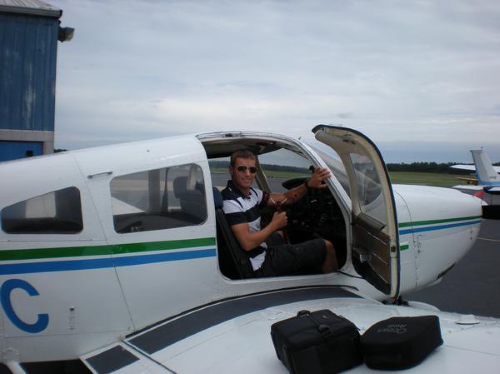
When I was contemplating becoming a pilot for a living, I was bouncing between a few schools:
- ATP
- My local flight school (Ocean Aire in Toms River, NJ)
- American Flyers
Ocean Aire would have been way cheaper (like $25K – $30K for all my ratings) than ATP ($55K+), so that was part of the consideration.
On top of that, I knew the instructors and the area well, plus I would have the luxury of having rent covered (living with your parents does have some perks).
American Flyers, which like ATP has locations all across the US, just struck me the wrong way when I was doing my research.
I chose ATP flight school for a number of reasons, but my top 3 would probably be as follows:
- I would get my ratings quickly
- I’d (possibly) be able to pick up a job as a CFI after completion of training
- I needed a break from the bleak winter NJ weather
‘I would get my ratings quickly’
Make no mistake about it, ATP flight schools biggest selling point is the fact that you can go from “0 to Hero” in under 6 months.
They advertise this ‘fact’ everywhere…
Airline pilot forums, pilot magazines, Facebook, Google, etc.
‘I’d (possibly) be able to pick up a job as a CFI after completion of training’
This was another selling point that stuck with me.
Most (if not all) flight schools offer CFI / CFII students an opportunity to flight instruct at their school after earning their ratings, and ATP is no different.
However, there’s a huge difference between most mom and pop flight schools and ATP…
At smaller flight schools, your chances of getting a student looking to earn his or her multi-engine ratings are low, at best.

At ATP flight school, it’s almost a guarantee that you’ll have multi-engine students.
In fact, you’ll likely have more multi-engine students than you will single-engine students.
The vast majority of those attending ATP will already have their private pilots license with a single-engine rating.
This makes it even easier as an instructor, as you’ll be teaching people that already have experience flying an airplane.
‘I needed a break from the bleak winter NJ weather’
Growing up in New Jersey has it’s perks…You’re within an hours drive of New York City, jersey shore beaches, and even the Poconos.
With that said, the winters in New Jersey just suck.
Sure, at first it’s not too bad, and it’s nice to have a change of season / scenery every once in awhile.
With that said, it gets old quick!
To top it all off, when I was doing my private pilots license, I can’t tell you how many flights I had to cancel because of bad weather.
Nothing sounded better than escaping all of that with a nice 4 – 6 month trip to South Florida!
My Complete Experience At ATP
Before I get into my full review of ATP flight school, I want to give you a brief on how the process goes (or at least how it did in 2008):
As I mentioned, ATP offers a wide variety of training programs depending on where you’re at in your aviation career.
It’s an ala-carte menu that ranges from something as simple as a private pilots license, to the full gambit.
Since I was looking to make this a career, I decided to go with the ‘Airline Career Pilot Program’.
I already had my private pilots license, so what this would entail was basically allowing me to earn every rating I would need to become qualified to fly as a commercial pilot and flight instructor (CFI).
These ratings included (in no particular order):
- Multi-Engine rating
- Instrument
- Commercial Multi-Engine rating
- Commercial Single-Engine
- CFI Multi Engine
- CFI Single Engine
- CFII
In order to pay the $55,000 cost, I had to secure a student loan from Wells Fargo.
At that time, rates were actually fairly reasonable, and it didn’t take long to get the funding.
To get into ATP flight school, I had to go to an ‘interview’ at one of their locations.
I chose the Daytona Beach location, as I was gunning to go to one of their locations in Florida. (more on this below)
My best friend and I flew down to Daytona Beach for a week (it was late January), and my ‘interview’ was conducted on a Tuesday.
I keep putting ‘interview’ in quotes, because it wasn’t really an interview.
Rather, it seemed as though it was basically a sales pitch of why I should attend ATP over another flight school.
Sure, they asked me some questions that were flying related.
But the vast majority of this ‘interview’ was them explaining why ATP was the best.
In any event, I ‘passed’ this interview and was accepted into their flight training program.
Related Article – 5 Best Low Time Pilot Jobs With 250 – 500 Hours
How I Ended Up In Stuart
As I mentioned earlier, I was gunning for a location in Florida.
At the time, there were around 6 – 7 ATP locations in Florida.
I was originally shooting for either the Ft. Lauderdale location, or the Daytona Beach location.
There were 2 problems with this:
1. Daytona Beach…Pass!!
Everything I read about the Daytona Beach location just turned me off.
From complaints about the instructors, to complaints about the living situation in Daytona Beach, it started giving me second thoughts.
All my suspicions were confirmed when I visited the Daytona Beach location in person for my interview.
2. Why Not Ft. Lauderdale?
Unfortunately, there were no openings at the Ft. Lauderdale location. Because this particular ATP flight school location is way smaller than many of the others, they only had a limited number of spots.
My admissions officer gave me a list of the other locations in Florida that were available at the time, and one of them included Stuart.
Up until that point, I’d actually never even heard of Stuart, FL.
After consulting a map, and checking out a few forum posts, I decided this was the location for me.
Living Accommodations / Rooming Situation at ATP Flight School
Fast forward to March 25, 2008, and I found myself checking into the Willoughby Cove apartments (now called Heritage Cove), about an 8 min. drive from Stuart airport.
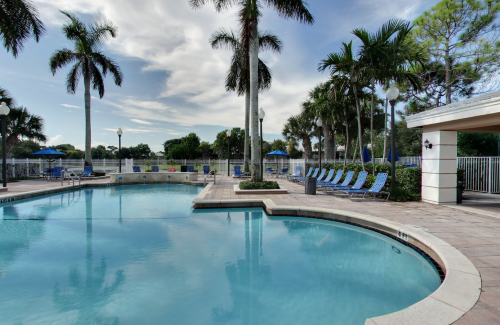
I met my roommates Kyle (who was also originally from NJ) and Luke (who was from Michigan), both of whom were approaching the end of their flight training.
The housing at ATP is basically setup like a college dorm, except, there’s only like 3 – 4 units (apartments) since we were at a smallish location.
Each unit in Stuart had 3 bedrooms, and 2 full bathrooms.
The ‘master bedroom’ had their own ‘master bathroom’, and the other 2 bedrooms shared a bathroom.
In Stuart, 2 of the bedrooms were setup with 2 single beds, and 1 of the bedrooms (the smaller one, not the master) was setup with 1 single bed.
The assumption was that, if a girl checked in to flight training and ended up in our apartment, she would get the single bedroom (for obvious reasons).
In all, you can expect to have 2 – 4 other roommates for the duration of your training at ATP.
Fun Fact: One of my roommates ended up becoming a chief meteorologist for a small TV station in Wisconsin!
What’s The Flying Like At ATP?
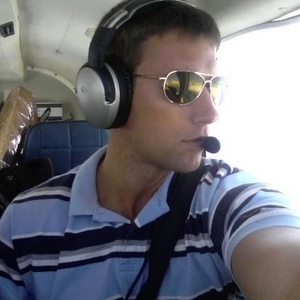
In general, there were 2 different types of flying done at ATP flight school:
- Training For Your Rating, and
- Cross-Country flying
Training For Your Rating
The training for your rating is exactly what it sounds like…every time you’re in the airplane, you’re receiving instruction from one of the CFI’s.
They make the schedule for your flights, and pretty much handle everything.
Expect to spend a lot of time in the simulator before you actually jump into an actual airplane.
You’ll quite literally do the entire flight that you’re going to do in the simulator first.
Once your instructor is confident that you can perform the required maneuvers, you’ll actually head out to the airplane for some real world flying.
This makes sense from both a practical standpoint (if you can’t do the maneuvers in a simulator, you probably won’t be able to do them in the airplane), and an economic standpoint (airplanes are expensive to fly!).
Be prepared to fly a lot!
From what I remember, I was flying as much as 4 – 5 times per week, with each flight being anywhere from 1.5 – 2 hours in duration.
In general, you’d get the weekends off.
With that said, it was still possible to be flying on the weekends depending on how the schedule played out.
Cross-Country Flying
The cross-country flying was a completely different animal. This type of flying was conducted as a ‘run up’ to your commercial multi-engine checkride.
Since you need 250 hours of flight time to be qualified to take the commercial checkride, ATP flight school pairs you up with another student to ‘build time’. [Ref: 2]
I happened to be partnered up with another guy from New Jersey, and we had a really good time.
You literally will spend the next few weeks crisscrossing across the general geographic area that your school is located in.
For example, since I was in Stuart, FL, most of our flights would start in Stuart, and we’d do like 3 – 4 legs per day.
A typical day of cross-countries would look like this:
1st leg: Stuart, FL (KSUA) to Jacksonville, FL (KCRG)
2nd leg: Jacksonville, FL (KCRG) to Raleigh-Durham Intl. Airport (KRDU)
3rd Leg: Raleigh-Durham Intl. Airport (KRDU) to Jacksonville, FL (KCRG)
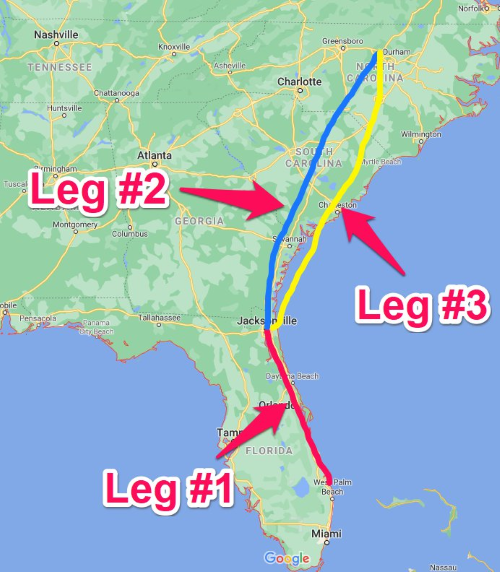
Then, we would spend the night in a hotel and do a totally different set of legs the next day.
Sometimes we’d end up back in Stuart at the end of the day, but the vast majority of the time we’d end up away from home (just like in the airlines).
Technically speaking, we were supposed to stay in one of the dorm rooms with students in whatever location we were in.
However, most of the time we’d end up at one of the apartments, only to find out that they didn’t have any spare beds available.
The last thing my flight partner and I wanted to be doing after a long day of flying was spending the night on the floor or some dirty used couch.
Luckily, he was cool enough to agree to fork over the $ for a hotel room.
At the end of the training, we actually sent in our receipts from our hotel stays, completely expecting to not be reimbursed.
However, much to my surprise, several months after completing training I found a check in the mail from ATP flight school.
It turns out, they reimbursed me for every red cent in expenses. (my flight partner as well)
Other destinations we routinely flew to included:
- Dothan, AL (KDHN)
- Naples, FL (KAPF)
- Ft. Lauderdale Executive (FXE)
- Peachtree Dekalb, GA (KPDK)
- Pensacola, FL (KPNS)
From what I can tell by the ATP flight school locations map, some of these locations (namely Naples and Pensacola) looks like they’ve closed.
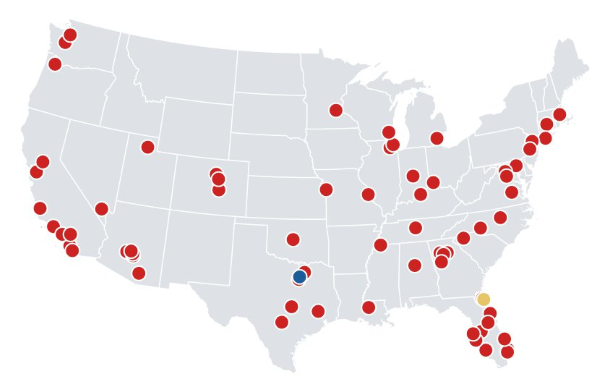
Although come to think of it, I don’t think they ever had a location in Naples, we just flew there for training.
What Are The Instructors Like At ATP?
Like most other flight schools in my experience, this is all over the map.
Some instructors are great, and will go the extra mile to make sure you understand all the material and answer any questions you may have.
Others do the bare minimum, and that’s putting it lightly.
Some instructors yell at their students for the slightest mistake, and some are extremely patient.
I actually almost got into a PHYSICAL fight with one of my instructors IN the actual airplane.
I won’t get into the details, but ultimately I switched instructors.
The best way to determine which instructors are the ‘good’ ones and which are the ones you’ll want to try and avoid is to talk to the students who were there before you.
For each rating, you’ll generally be assigned a different instructor.
For example, the instructor that did my instrument and multi engine ratings was the same guy.
However, for my commercial and CFI ratings, I had 2 completely different instructors.
I’m not exactly sure how they choose your instructor, but I think they basically just rotated students based on who was coming in, and who was going out.
Sort of like on a first come, first serve basis.
One thing about some of the instructors at ATP that sort of annoyed me was their arrogance.
Here were guys (yes, they were all males) that quite literally just got their CFI / CFII certificates like 6 months prior to me getting there.
This means that, in essence, they were basically in my exact same shoes less than a year ago.
The way some of them acted, however, was like they were gods gift to the world of aviation.
A Chuck Yeager impressionist, if you will…
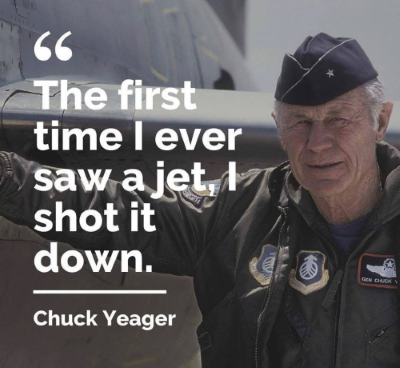
If you had a question about a Federal Air Regulation (FAR), or about something on an aeronautical chart, or whatever the case may be, often times they’d look at you like ‘how dare you ask me that?!’.
Other times it was with a condescending attitude, as if you’re a complete idiot for not knowing the answer to a particular question already.
Frankly, it was a bit annoying, but I learned to live with it.
Related Article – Instrument Proficiency Check (IPC): 4 Things You Need To Know
What Are The Designated Pilot Examiner’s (DPE’s) Like?
Frankly, there’s not too many negative points I can think of when it came to the DPE’s.
They were all very professional, and you could tell from the get-go that they were fair (albeit pretty intense in some cases).
For example, my first DPE for my multi-engine checkride was a former Air Force F-4 Phantom pilot that flew combat missions over Vietnam.
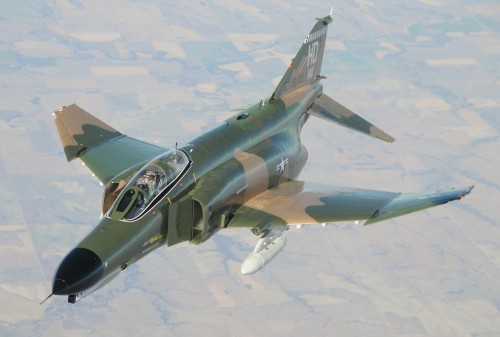
To say that I was anxious about this particular checkride would be an understatement.
We started off the checkride with the oral exam, which is basically a sit-down ‘interview’ if you will.
The examiner will ask you a bunch of questions related to the rating itself, and can include everything and anything.
For example, on this particular checkride, I remember the DPE asking about:
- The aircrafts performance metrics (stall speed, max. speed, cruise speed, service ceiling, etc.)
- Critical Engine – Which engine is critical and why (in the PA-44, it’s the left engine in case you were wondering)
- Emergency procedures (IE you just lost the critical engine, what are you going to do?)
He also asked me a range of other questions, ranging from weather to airfield operations, to pointing at a VFR chart and asking me about a variety of symbols.
At ATP, your DPE can vary for every checkride.
For me, it broke down like this:
- Multi-Engine rating: DPE #1
- Instrument rating: DPE #2
- Commercial and CFI Single Engine ratings: DPE #3
- Multi Engine Commercial and CFI ratings: DPE #4
Depending on the ATP flight school location you end up at, you could quite literally have the same DPE for every checkride you do.
Also, on one of my checkrides I literally did 2 different ratings back to back on the same day.
On that particular checkride, we started off with the single engine commercial checkride.
After successfully completing the required maneuvers, we landed at the DPE’s home in Spruce Creek, FL.
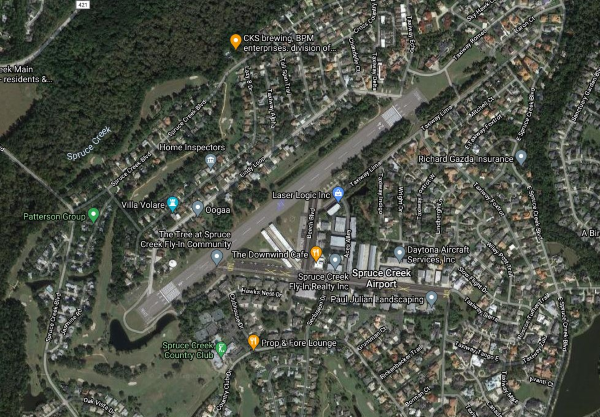
We literally taxied right up to his house, he filled out the paperwork stating that I successfully completed the Commercial Single engine checkride, and we hopped back in the airplane and did the Single Engine CFI checkride.
To say it was a long, rough day of flying is an understatement!
What’s CFI School At ATP Like?
In my experience, CFI school at ATP flight school, by and large, wasn’t very good quality training.
I’ve heard that they’ve completely overhauled it since I attended, but I can’t confirm that.
As of 2020, ATP has 5 locations for their CFI academy.
They include:
- Phoenix Gateway Airport (KIWA)
- Centennial Airport (KAPA)
- Arlington Municipal Airport (KGKY)
- Gwinnett County Airport (KLZU)
- Craig Airport (KCRG)
Because it was closest, I was sent to the Jacksonville location to do the CFI ground school.
There were about 10 other students in the course, and we had one ground instructor (a former first officer at a regional airline).
From what I recall, the school lasted 2 weeks, and was divided up into 2 blocks. The first block, which lasted a week, involved actual ground school instruction.
The 2nd block, which also lasted a week, basically involved self-study in the classroom.
I’m having a really hard time remembering everything that happened, but I do distinctly remember getting the feeling that they were trying to get students to quit training.
In fact, my roommate Luke did just that just a month prior to me attending ground school.
Come to think of it, I remember him being so fed up by the program that he ended up leaving before finishing his CFI ratings.
Let’s just say, at the time the school was ‘lacking’ in many aspects.
For one, there isn’t a ton of actual ‘ground school’. The classroom instruction that was given was sort of lacking in any detail, and it just all around seemed unstructured.
As I mentioned earlier, it sounds like they’ve cleaned up their act big time.
From their website, it appears that CFI academy is now 6 weeks, and is a much more involved program.
Spin Training!
The last thing I remember about CFI school was one of the most fun (if not terrifying) aspects of training….spin training.
You see, in order to receive your CFI ticket, you need to get several endorsements.
They include:
- Endorsement for aeronautical knowledge
- Endorsement for flight proficiency
- Endorsement to certify completion of prerequisites for a practical test
- Endorsement for spin training
Up until this point, I had never been in an actual spin.
Sure, I read the theory, understood what caused them, how to avoid them, and lastly the recovery procedure to get yourself out of one.
With that said, I had never actually been in a spin.
Like I mentioned above, being able to successfully demonstrate spin recovery procedures was necessary to receive your CFI ticket.
They brought all 10 of us out to the airfield and one by one took us up in a Cessna 152 to do it.
We’d take off to the southeast, and head about 10 miles to the east – southeast of the airfield (out over the ocean) up to around 7,500 ft.
There, the instructor would demonstrate a couple of spins himself to help walk you through the recovery procedure.
Then, he’d turn the controls over to you and, well, you’d put yourself in a spin and get yourself out of it!
For those of you that are unaware, it looks like this:
I’m not gonna lie, on the flight out to the training area I was pretty damn nervous!
With that said, I simply rehearsed the recovery procedure over and over in my head until it was time.
After the first couple spins, I was actually having fun!
We did a bunch of spins in both directions, and then headed back to the airport. All in all it was great!
ATP Flight School Crashes (personal story here)
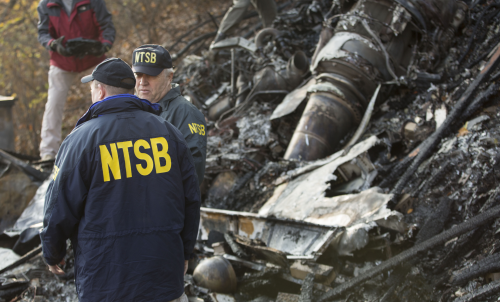
Like most other large flight schools, ATP has had it share of accidents and incidents.
As a matter of fact, I have a personal story to share about one of them.
In 2008, I was working as a flight instructor at a place called Naples Air Center.
I had just got home after a long day of flying, when I looked down at my ringing cell phone and saw that my old roommate Kyle was calling.
I answered my phone and that’s when he told me…
My old instructor, who we called Mainerd (because he was from Maine), was involved in a mid-air collision with another airplane.
The accident happened on Saturday, December 6, 2008, and I can remember everything very vividly.
Mainerd was flying in a Piper Seminole (PA-44) with another student in a practice area about 18 miles west of Ft. Lauderdale Hollywood International Airport.
Meanwhile, another instructor and his student were in the same training area in a Cessna 172.
From the NTSB’s official report [Ref: 3]:
“A Cessna and Piper were both on instructional flights, operating in a concentrated flight training area that is depicted on a sectional chart. There was no air-to-ground communication in the area, but there was an advisory frequency that was used by the flight schools in the area.
The Cessna’s pilot reported that he was “…a Cessna 172 holding at FRDDY at 2000 feet.” No other radio transmissions were heard from the Cessna, and there were no reports of any radio transmissions from the Piper. Radar information indicated that the Cessna was on a 210-degree course and was tracking at a speed of 86 knots.
The Piper was on a course of 160 degrees and was tracking at a speed of 126 knots. Both airplanes converged on the same position, and the collision occurred at about 2,000 feet above ground level. The reported weather about the time of the accident included clear skies and visibility of 10 miles.”
My girlfriend at the time (now wife) and I traveled to his hometown in Maine for the funeral, and it was also attended by many of my friends from ATP.
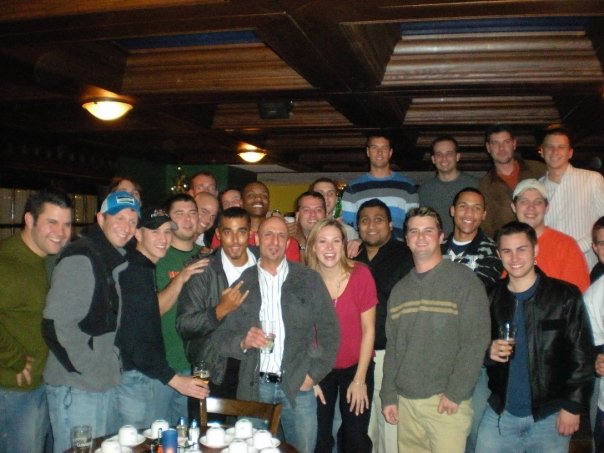
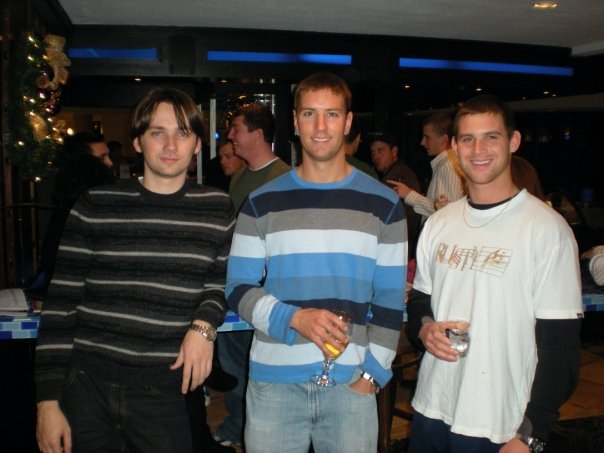
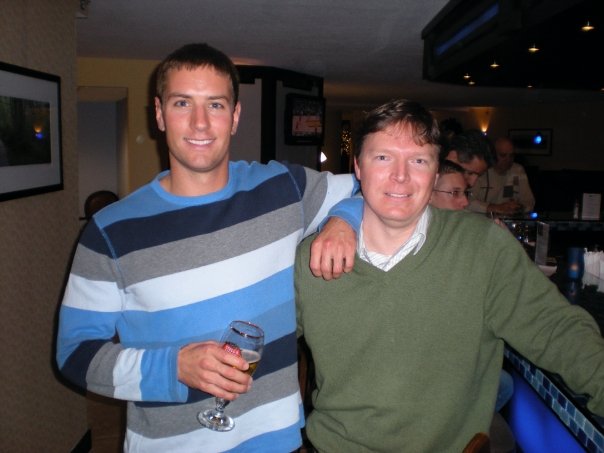
It was a pretty difficult thing, but if you’re involved in aviation for any length of time, you’ll likely experience the same thing.
To date, there have only been 2 other accidents that involved aircraft from ATP flight school:
March 24, 2014
Two students were on a cross country training flight when they experienced a vacuum pump failure in Instrument Meteorological Conditions (IMC).
The pilot flying subsequently lost control, and the aircraft suffered an in-flight breakup.
From the official NTSB final report [Ref: 4]:
“The National Transportation Safety Board determines the probable cause(s) of this accident to be:
An inflight failure of the airplane’s only operating vacuum pump, which resulted in the loss of attitude information provided by vacuum-driven flight instruments. Also causal was the pilots’ failure to maintain control of the airplane while operating in instrument flight rules (IFR) conditions, likely due to spatial disorientation, following the failure of the vacuum pump.
Contributing to the accident was the operator’s decision to dispatch the airplane with a known inoperative vacuum pump into IFR conditions.”
Unfortunately, both pilots were killed in the incident.
June 9, 2018
A Piper Seminole was on an approach to land at Daytona Beach airport in Florida when it experienced a microburst.
From the NTSB’s preliminary report [Ref: 5]:
“The flight instructor stated they received a local instrument clearance and were on the RNAV RWY 16 approach when they encountered rain around the final approach fix. The rain increased in intensity as they continued the approach. Shortly after passing the final approach fix they received a low altitude alert from air traffic control. The flight instructor added full power and attempted to climb; however, the airplane continued to lose altitude while “still indicating 90 knots throughout descent and impact.”
In my personal opinion, ATP Flight School goes to great lengths to make sure that their instructors and students are safe.
They have to in order to maintain their reputation.
It’s no more (or less) dangerous to get your flight training done here than it is most other schools.
Wrapping up, here are my final thoughts on Airline Transport Professionals (ATP).
What I Liked About ATP
- You can get your ratings really fast.
- The training is fun.
- The aircraft seem really well maintained. We never had an issue with an aircraft breaking down at all.
- They have a ton of locations across the US. There’s a good chance you live pretty close to one.
- My roommates and classmates were awesome.
What I Did NOT Like About ATP
- Ground school was virtually non-existent. You needed to be a ‘self-starter’ to succeed on that front.
- Instructors were a toss up. You’d either get a cool one or a douche. (Not limited to ATP flight school of course!)
- The training is a fire hose of information.
- You couldn’t just take an airplane for the proverbial $200 hamburger. All flights were training flights, including your cross countries.
Final Thoughts / Recommendations
If you would have asked me back in 2008 once I completed ATP if I thought it was worth it, I would give you the same answer then as I’m about to give now.
Yes…I would definitely recommend it.
While the training was intense, it enabled me to get all my ratings as quickly as possible.
For some guys and gals, this isn’t so easy to accomplish.
With that said, if you’re motivated enough and study hard, there’s no reason why you shouldn’t succeed at ATP flight school.
One thing I wanted to add to this review was, should you decide to go to ATP flight school, you should 100% get your written tests done before you go.
I can’t begin to describe how important this was to my success as a student at ATP.
While my roommates and other students were cramming for their written tests, and preparing for the checkrides, all I had to do was learn how to fly the plane.
This made life immeasurably easier for me than it was for them.
If you have any specific questions about ATP, feel free to leave them in the comments below!
References
- https://en.wikipedia.org/wiki/ATP_Flight_School
- https://www.aopa.org/training-and-safety/active-pilots/safety-and-technique/operations/commercial-pilot-certificate
- https://app.ntsb.gov/pdfgenerator/ReportGeneratorFile.ashx?EventID=20081208X81624&AKey=1&RType=HTML&IType=FA
- https://app.ntsb.gov/pdfgenerator/ReportGeneratorFile.ashx?EventID=20140324X00546&AKey=1&RType=Final&IType=FA
- https://www.ntsb.gov/_layouts/ntsb.aviation/index.aspx

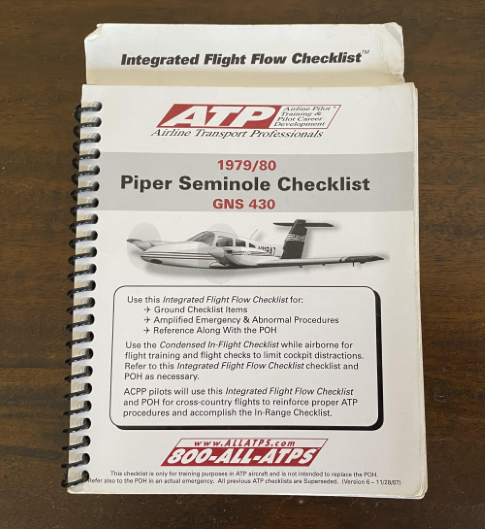

When you said get your written tests done before you go, does that mean all of them? PPL, Instrument, Commercial, CFI, CFII, MEI? If you could elaborate that would really helpful!
Yup, all of them, and basically in the order of which rating I’d be taking my checkrides in (so the way you listed). So I’d study my ass off for 1 week for the Instrument written test, take 1 or 2 practice tests, then go and take the actual Instrument written exam.
Then I’d take a day or 2 off from studying, and then study my ass off for the Commercial written. Take 1 or 2 practice tests, then go take the actual test. Rinse and repeat.
I really can’t stress how much pressure this took off of me when I arrived at ATP in Stuart, and just made for an overall better experience.
All I had to do was focus on the flying portion, which in my opinion helped me never fail a checkride. On top of that, while my roommates were stressing out, cramming for not only the written tests but also their checkrides, I was spending a good portion of my time chasing girls and going to the beach.
IF I had to do it all over again, I would do it exactly the same. Hope this helps and let me know if you have any other questions!
Rob V.
Century-of-Flight.net Founder
If you don’t have a PPL can you still take the required written tests before starting? Did you have all of your ground courses finished before starting at APT? How would one go about finishing all the written tests before starting flight school? Your blog has been a big help, thank you.
Hey Bowen,
Sorry for the late reply. To answer your question, yeah you can take any and all of the written tests before attending ATP. In fact, you can take any of the tests before you even step foot in an airplane. With that said, I recommend getting your PPL first before taking any of the more advanced written tests (i.e. Instrument written exam, Commercial written exam, etc.).
Hope this helps and good luck!
Rob
Century-Of-Flight.net Founder
I know you were at ATP a while ago. I’m considering it but what I’m worried about is money, can I work weekends at a place by the airport? Because I don’t think I can go 6+ months not working at all just doing ATP.
Hey Melissa,
Nah unfortunately I doubt it. I don’t recall any of my roommates / fellow aviators in the other apartments having a job at the time either.
The problem is, you basically have to have a completely open schedule while you’re there.
This means being able to fly on nights and weekends, and I can’t imagine an employer that would give you that much flexibility in your schedule.
Basically when you take out the loan to attend ATP (assuming you go the loan route), you’re taking out enough to pay for all the courses, as well as cover your expenses.
In my case, I had a full-time job before I left, so I had saved up a decent amount of money to cover living expenses.
Best regards,
Rob V.
Century-of-Flight.net Founder
I’m really considering and reading about different programs, given my stage of life ATP seems the best fit. How’d you prepare for and take the written tests prior to going? Did you purchase materials and practice tests online from multiple sources or do you recommend specific resources?
Thanks,
Hey James,
I used the King Schools tutorials to study for all of the written tests. At the time (2007 – 2008), it was only available in a physical book. It looks like they now offer it in an online format. They’re a bit expensive, but it was completely worth the price in the end.
I scored 90+ on every test I took, and it really helped with my overall preparations.
Here’s a link to their Career Pilot test kit prep program – https://www.kingschools.com/ground-school/career-pilot/kit
It’s got all the necessary study tutorials if you’re looking to get all of your ratings.
IMPORTANT – I’m not sure what stage you’re at in your aspirations, but if you haven’t gotten an Aviation medical yet, don’t buy anything until you do.
You cannot fly as a commercial pilot without passing an Aviation Medical exam, period.
You can find an AME near you here: https://www.faa.gov/pilots/amelocator/
Hope this helps and let me know if you have any other questions!
Best of luck,
Rob V.
Century-of-Flight.net Founder
Hi! My son is 17 and will be graduating in 2022. He will probably have his private pilot certificate within the next three months. He is now deciding what route to go. It is so overwhelming with how many different paths you can take to become a pilot. We are also in New Jersey, and Mercer County College has a two-year program for $60,000 where you would come out with an associates degree as well. Do you regret at all not going to a college? I have read on many sites that major airlines do prefer a college education. Any insight would be great!
Oh I went to college haha, almost too much college! I have a B.S. in Management, and an MBA. You’re absolutely right, most airlines require a college degrees, usually a 4-year one. If money isn’t an issue, ATP will get him his ratings very quickly. The proverbial ‘pilot shortage’ that they were pushing back in 2008 has finally started to actually happen.
Before Covid-19, the airlines and flight departments across the country were in a bit of a bind. There was a huge lack of pilots and a growing need for them. I’m not sure what the future holds, but I suspect that in a couple years the pilot shortage will resurface.
Long story short, it will be a great time to become a pilot. Hope this helps and sorry for the late reply!
Thanks so much for the article. I really enjoyed reading. I am too old to fly, but it was interesting to read about your experience and training! Great read!
Yep no problem Barry, it was fun writing it. Brought back a lot of good memories!
Rob V.
Owner / Founder
Century-of-Flight.net
I was all in with ATP until last night— I found a lot of negative reviews about ATP. Some said it’s a “scam”, overpriced, and atp just doesn’t care about. They said they only care about the money. Any opinions on that? Also, some negative two shoes said the pass/fail rate is not what’s advertised which they say is 30 percent or less? True? I’m looking to change careers but at my age (late 30’s) I’m now doubting this program. Should I doubt the program?
Yeah I mean, at the end of the day, they’re a business that’s ‘in it’ to make money. As for being overpriced, I sort of touched on that in the review. If you’re looking to save money, your best bet would be to get your ratings at a local flight school. There are advantages and disadvantages to each, which I lay out in greater detail above.
As for the pass / fail rate, I don’t have any firm statistics on that. With that said, from what I recall nearly every single one of my roommates failed at least one of their check rides. How this rate compares to a local / smaller flight school I have no idea.
I think a lot of guys and gals go to ATP expecting to have their hand held, which is simply not the case. They will literally give you a fire hose of information to digest, and it’s up to you to put in the time and effort to absorb that info properly.
I can see how this can come across as them ‘not caring’. You really have to be a self-starter / self-motivated to be successful with the program, and not everyone has this trait.
The program works if you’re willing to put the time and energy into it. Hope this helps and good luck!
Rob V.
Century-Of-Flight.net Founder
Hi Rob,
This is an amazing read and helped me a lot. I am helping my daughter (22), an immigrant from a traditional and conservative society in Afghanistan! She is very interested in becoming a pilot (commercial, eventually!), her (and our) biggest motivation is that she wants to do something different and that she could send the young girls back home the message that women are similarly capable of achieving whatever they put their mind to! She is a high school graduate (in the U.S.) and is currently enrolled in a community college (first year). We are doing our research and came across your article. Sorry for the long speech, but we would highly appreciate your help with answering the following questions:
– Would you suggest the ATP vs a Bachelors in Aviation?
– Seems like you enrolled directly due to your prior license. Is there any benefit in signing up/enrolling through one of the airlines (United Aviate, for example)?
– Any other words of wisdom with keeping her situation in mind?
Thank you!
Hey Umer,
Not a problem, glad to help! Answers to your questions below:
1. “Would you suggest the ATP vs a Bachelors in Aviation?”
If her ultimate goal is to become an airline pilot, then she will definitely need a bachelors degree. Does it need to be in aviation? Not necessarily.
With that said, if she gets a degree in aviation, it will significantly reduce her flight time requirements for getting a restricted ATP. You can learn more about that in my article here: https://www.century-of-flight.net/restricted-atp-explained/
2. “Seems like you enrolled directly due to your prior license. Is there any benefit in signing up/enrolling through one of the airlines (United Aviate, for example)?”
Absolutely! If the United Aviate program was around in 2008, I would have taken that route for sure. With that said, as far as I’m aware it’s a VERY competitive process that only a select few make it through.
3. “Any other words of wisdom with keeping her situation in mind?”
The best piece of advice I can give is this: Realize that aviation is a very dynamic / dramatically changing industry.
It has enormous ups and downs, meaning, when there’s a boom it’s a great time to be a pilot. Alternatively, when there’s a ‘bust’, it’s a terrible time to be a pilot.
I was talking to an airline captain once, and after I asked him how great it is to be an airline pilot, he remarked ‘being an airline pilot is the best part time job I’ve ever had!’.
There’s a lot of truth in that statement, unfortunately…
US airlines (and really all sectors of aviation) weren’t exactly ‘hurting’ for pilots back when I went through training. There was essentially a surplus of pilots and a lack of jobs.
Prior to COVID-19, the last few years has been the opposite. The dreaded ‘pilot shortage’ aviation experts were warning about back in 2008 – 2009 was finally coming to fruition.
In fact, even though I haven’t flown for a paycheck since like 2011, a couple years back I was getting letters from regional airlines on a monthly (sometimes Bi-WEEKLY!) basis.
All of them were pleading for me to apply to their airline to become a first officer (since I meet the ATP requirements), and dangled $20,000+ bonuses in my face to entice me to do so.
With that said, COVID-19 changed all of that (for now)…Long story short, get ready for a bumpy (yet very fulfilling / rewarding) career!
Hope this helps, good luck!
Rob V.
Century-of-Flight.net
Thanks for the info Rob. My question happens to involve with United Aviate vs ATP since you just brought it up. I have zero experience. I was thinking if I were to jump into a career, who should it be with between the two, and why? (I live in Scottsale, AZ, so I’m looking at programs here) I was really looking at ATP, but was told to look into United Aviate too. Plus, you just said you would have chose them over ATP, why? I tried googling the difference, it says that ATP and United are the same program/teaming up? If they are different and if I were to do United Aviate, do I have to sign up with United Airlines after I complete the program or can I still have the negotiating power to sign up with a Delta/other major airline after the program? Sounds like the program is made only for United Airline “future” pilots.
Thanks in advance!
Hey Colter,
Sorry for the late reply, I don’t check comments very often. Answers to your questions below:
“I was thinking if I were to jump into a career, who should it be with between the two (United Aviate vs ATP), and why?”
I would have chosen United Aviate because they pay for your private pilots license (PPL). In addition, joining their program puts you on a path to ultimately work as a pilot / first officer at United Airlines.
While my initial interest was getting into corporate aviation (specifically Netjets), I would have seriously considered going the airline route if I knew I’d be getting a (virtually guaranteed) slot at United.
Lastly, the UA program seems very structured / professional, and they spend a great deal of time on ground instruction. This was virtually nonexistent at ATP at the time I went (2008)…you 100% need to be a self-starter to succeed (which ultimately I was).
Given you already live in Scottsdale, I think the UA program is a no-brainer for you!
“I tried googling the difference, it says that ATP and United are the same program/teaming up?”
It sounds like (and I could be wrong here), you can apply to the United Aviate program while you’re in the ATP Airline Career Pilot Program.
To me, this just sounds like United is poaching future pilots from guys / gals that already signed up with ATP.
This sounds unnecessary, especially considering United will pay for your PPL (which ATP, of course, will not).
“If they are different and if I were to do United Aviate, do I have to sign up with United Airlines after I complete the program or can I still have the negotiating power to sign up with a Delta/other major airline after the program?”
I highly doubt that United would invest all that time and money into you if you were planning on ‘jumping ship’ somewhere down the road.
There’s probably a clause in the contract somewhere that says ‘you need to work for us for X amount of years, and if you leave to work for another airline, then you need to pay us back $X amount of money’.
Of course, don’t quote me on that, that’s just my instinct! Long story short, if I were your dad or older brother, I would tell you this:
GO THE UNITED AVIATE ROUTE IF YOU CAN!!!
Hope this helps and let me know if you have any other questions!
Rob V.
Century-of-Flight.net Founder
I have a kid that graduated from
ATP and was offered a job at as large university with a flight school 2 weeks into training ATP steps in and offers a job at the location she wanted. What would you recommend as the best place to get your hours . I am concerned about safety first … and then that they will be able to get a quality job with a major airline. The question is Big university for getting hours or ATP school?
Hey Connie,
Sorry for the late reply, I don’t check comments very often. Answers to your questions below:
“What would you recommend as the best place to get your hours?”
I’m not sure which university you’re referring to, but if it’s as large as you say, then she would likely get the same amount of hours working for either.
From a safety perspective, again, I don’t know what university you’re referring to, so I don’t have a clue as to their safety record.
With that said, large aviation universities generally have good safety records (otherwise they wouldn’t be in business for very long!).
In short, either path will likely get you the hours necessary in the shortest period of time, qualifying you for a job with a regional airline.
Hope this helps and let me know if you have any other questions!
Rob V.
Century-of-Flight.net Founder
Similarly to you, I graduated with a business degree. As I’ve entered the corporate world, I don’t exactly love what I’m doing and considering a career change. I’m very interested in becoming a pilot, but I’m worried about the chances of getting a job upon graduation of ATP. What was your experience working as a pilot upon graduation and what would you say the odds of getting a job out of ATP school are?
Thanks for the article!
Hey Luke,
Sorry for the late reply, I don’t check comments very often. Answers to your questions below:
“What was your experience working as a pilot upon graduation?”
I had a very rough time upon graduation. I first ended up working as a CFI at the flight school in NJ where I did my PPL (KMJX). Ultimately, however, I just wasn’t getting enough hours / students, so I ended up taking a job as a CFI / CFII at a flight school in south FL (Naples Air Center).
That job was great…I got a ton of students and flight time, and ended up with just over 1,000 hours dual-given by the time I left.
With all of the above said, the market for pilots right now is WAY better then it was back when I was flying for a paycheck.
Airlines (and subsequently smaller corporate type outfits) are in a world of hurt looking for pilots, as there is a major shortage. If course COVID screwed all of that up and killed air travel for awhile there, but it’s starting to come back big time.
I actually get postcards from regional airlines begging me to apply (and dangling BIG bonuses over my head), that’s how desperate they are right now.
If all goes smoothly and the industry starts to rebound as expected, you will have absolutely NO issues getting a job as a pilot in the near-long term future.
It’s a very different world then when I was flying for a living, that’s for sure.
Hope this helps and let me know if you have any other questions!
Rob V.
Century-of-Flight.net Founder
Hey Rob,
I’m looking for a career change, and am interested in getting into Aviation. I am looking into ATP for flight school.
Questions
1) What would you consider “Too Old” for transitioning into an Aviation career? I would be considered a “Newby”.
2) How Hard/Easy would it be to find a “Local Aviation Job” near me? I have family and would like to be home after work.
3) Can someone make a permanent career out of “Teaching Students” at a Flight School like ATP? Is it heard of?
Thanks for your time.
Todd.
Hey Todd,
Sorry for the late reply, I don’t check comments very often. Answers to your questions below:
“What would you consider “Too Old” for transitioning into an Aviation career? I would be considered a “Newby”.”
I have seen guys in their 50’s enter into aviation as a 2nd career. In fact, my very first flight instructor did just that. He was a northern NJ cop for like 20 years, and became a CFI (and later a corporate aviation pilot) after he retired from the force.
“How Hard/Easy would it be to find a “Local Aviation Job” near me? I have family and would like to be home after work.”
This is tricky….if you want to really ‘succeed’ as a pilot, you really need to be flexible with your living arrangements. With that being said, it’s entirely dependent on where you live and how many pilot job openings there are near you.
For example, I live in South FL, and there are TONS of places for me to work as a pilot. Flight schools, charter companies, sightseeing tours, airlines, etc….the list is endless.
However, someone living in Whitefish, Montana will have very limited options. If you see this comment, leave a reply and let me know where you live. I might be able to give you a good idea of what you can expect.
“Can someone make a permanent career out of “Teaching Students” at a Flight School like ATP? Is it heard of?”
Is it possible? Yes. Is it likely, not really. Being a CFI (at least in the traditional sense) is really a stepping stone to a larger career in aviation (i.e. airlines, corporate aviation, etc.)
With that said, again, this is entirely dependent on where you live and how busy a nearby flight school is. For example, I worked in 2 different places as a CFI: Ocean County Airport (KMJX) and Naples Municipal airport (KAPF).
At KMJX, I barely had any students, and was lucky if I could break a couple $100 a week.
At KAPF, I felt like I was in the air more than I was on the ground haha. I had so many students that I was easily clearing $1,000 a week (this was 2009, so it would probably be higher nowadays).
It should also be noted that I was working my @ss off, somewhere around 50 – 60 hours a week of ground / air instruction. With that said, I was home every night and loved the job. I was also in my 20’s and had no wife & kids, so, food for thought.
Hope this helps and let me know if you have any other questions!
Rob V.
Century-of-Flight.net Founder
Hey Rob,
I am 16 and graduating in 2023 and getting my pilots license next may and I have been looking into ATP and Purdue University but I also have been looking at my local flight school at Goshen municipal but mainly I have been focused on the Envoy Cadet Program because of their incentives but I do have a couple questions that you might be able to answer.
1) Envoy displays on their website their partner schools which includes ATP but I have been wondering if it is possible if I could train at my local flight school (since I am already getting my PPL from there and it would be much cheaper than ATP) then instruct at ATP and still be able to get into the program and save a lot of money and get free living since my parents live 23 minutes away.
2) Envoy says they will give you a spot at American but what are the chances to get into the program
And another thing to add is that I could definitely get all my written tests done from when I complete my pilots license at 17 and when I graduate high school at 18 and be completely ready for training
Hey Carson,
Sorry for the late reply, just reading through comments now. Answers to your questions below:
1.) I’m really not super familiar with Envoy’s Cadet Program, so your guess is as good as mine. I will say this, if you were to do all of your ratings at your local flight school, I’m not so sure you’d be picked up as an instructor with ATP upon completion.
Flight schools tend to hire their CFI’s ‘from within’, meaning if you did all of your ratings at ATP then you would stand the best chance of being picked up as an instructor with them.
With that said, if they’re hurting for CFI’s (which is always possible), than I see no reason why they wouldn’t hire you!
2.) As I mentioned above, I really don’t know. If I had to guess, competition is probably pretty stiff with ALL of these cadet programs (Envoy, United Aviate, etc.). So their acceptance rate is probably low. Keep in mind this is a guess, albeit an educated one.
Hope this helps and let me know if you have any questions!
Rob V.
Century-of-Flight.net Founder
Great read, Rob.
So was your intention to fly for the airlines or corporate after ATP? Is that what you’re doing now?
I’m also, as others, thinking of a mid-life career change and looking at ATP. My intention is to eventually end up in the airlines or corporate, but I’m interested in why some may not end up going that route.
I have my PPL, A&P, and in the airplane manufacturing business; but the itch to fly, for a living possibly, is strong.
Thanks,
Mike
Sorry for the late reply, Mike. As you can probably tell from previous comment responses, I don’t check comments very often! My ultimate goal was to fly for a company like Netjets. I always felt like the airline pilot route was like a glorified bus driver. You fly the same routes day in and day out, have crazy odd schedules, and are at a high risk of being furloughed.
No matter how bad the economy is (2008 collapse), what virus shuts down air travel (COVID-19), what terrorist incident grounds planes (9/11), one thing is for sure….Super wealthy people will ALWAYS be flying private.
Couple that with extremely good pay / benefits, the opportunity to fly (and possibly network with) celebrities / high net worth individuals, going to cool places, etc….it seemed like a no-brainer.
At the time I was flying for a living I was also doing internet marketing / affiliate marketing, which is what I do full-time today.
I make WAY more money now than when I was flying for a paycheck, but every once in awhile I think about jumping back in the cockpit.
Hope this helps and good luck in whatever career you choose!
Rob V.
Century-of-Flight.net Founder
How long would schooling take if I have had no prior flight experience or license?
And where could I take and finish the written pieces?
Hey Miles,
You can go from ‘Zero to Hero’ in probably around 6 months. With that said, it would be dependent on a number of factors like how well you learn everything, your overall aviation skills, budget, etc.
I always recommend to ANYONE that is seriously thinking about becoming a commercially rated pilot do 2 things before you start applying for $100K flight school loans:
#1. Find an Aviation Medical Examiner (AME) near you and get a 1st Class Medical certificate.
It’s a pretty standard physical exam, but they pay special attention to eyesight (overall vision, peripheral vision, color blindness, depth perception, etc.) and other flying-related medical conditions. Bottom line, if you can’t pass an aviation medical exam and get a 1st class medical, then you won’t be able to fly for a living.
#2. Go to your local flight school and take a short ‘Introductory Flight’.
I can’t tell you how many students I had when I was a CFI that had never been in a small plane before, yet thought they wanted to be a commercial pilot. Some of them would be barfing on every flight at the slightest hint of turbulence. One would simply freeze up during the flare and could NOT land the plane, no matter how many different ways I tried to show him. I even had a student physically grab on to me when I was demonstrating a power-on stall. He was completely terrified!
Long story short, make sure you have the physical ability (i.e. the 1st class medical) and the TRUE desire (i.e. Intro Flight) to want to do the job.
Do all this and then come back to me and we’ll talk about written exams. Hope this helps and let me know if you have any other questions!
Rob V.
Founder, Century-of-Flight.net
Hi there.
I read your post about your time at the ATP flight school. It was really good. Thank you.
I am considering ATP as well, and was wondering what your thoughts were on the 100 hour multi-engine option were.
Thank you.
Sincerely,
T
Hey T,
Yeah if you already have your PPL, then the 100 hour multi-engine option is a good way to build multi-engine time quickly. One of the biggest benefits is the potential ability to hook up as a CFI with them after you’ve completed your ratings. This is actually one of the biggest all-around benefits to ATP. What I mean by this is, when you flight instruct at a ‘smaller’ flight school (like your local FBO), you’d be lucky to get ANY multi-engine time as a CFI(I).
At ATP, pretty much ALL you’ll be flying at ATP is multi-engine aircraft (i.e. Piper Seminole), which is huge from a resume-building POV. Hope this helps and let me know if you have any questions.
Rob V.
Century-Of-Flight.net Founder
Hey, Rob!
Thanks for taking the time to share your perspective- I appreciated the information and objectivity.
Best,
Adrienne
No prob, glad you enjoyed the article!
Rob V.
Century-Of-Flight.net Founder
Rob, this is a great read and full of good/useful/practical information. One of my sons is pursuing commercial aviation, has his Medical Certificate, and plans to start in the spring as he finishes his two year degree. You’ve shared some of your experiences and have been very generous with your time. I’m a USAF C-130 pilot (retired) and am helping him as much as I can. One question: How many of your ATP peers went on to fly for a major airline? Thanks again.
Hey Kerry,
Thanks for your kind words. I actually had fun writing this, it brought back a lot of good memories. As for your question, nearly all of my ATP peers (at least the ones that stayed in aviation as a career) have gone on to bigger and better things. Some of them are flying for the Majors: 2 are at Spirit Airlines, 1 is at JetBlue, and I believe 1 got picked up by United recently.
The ones that didn’t move on to the majors are sprinkled into other, high-paying flying gigs. I know 1 is at Kalitta Air, 1 is at Piedmont, and 1 works at a corporate flight dept.
Even my old roommate Luke (who if you read above dropped out of CFI training before completing it) is a captain at a regional (Delta Connection, if I’m not mistaken).
I have no doubt that if I had stayed in aviation as a career, I’d be at the majors (or Netjets, which was my initial goal).
Rob V.
Century-of-Flight.net Founder
p.s. My old boss at a charter company in Stuart I used to fly for was a former C-130 driver. Had some interesting stories to tell!
Hi. I read that you are from New Jersey, why you did not go to the ATP locations in NJ? Just curious since my son planning to go in ATP Morristown. Would you recommend the NJ locations? And we are also deciding between the regular 25 hour ME versus their 100+ ME program, which one would you recommend?
Hey Ana,
Thanks for your comment, and sorry for the late reply. I touched on this in the article above, but here’s the TLDR:
1. I needed a break from the crappy NJ weather. If you live in NJ in the winter you know what I’m talking about 🙂
2. Related to the above: Bad weather typically means no flying, as a general rule. Since the weather in south FL is so much better, the chance of a flight being cancelled due to weather is way lower down here then in NJ.
There’s nothing wrong with going to the NJ locations, but the above was my rationale.
As for the multi-engine question, def go with the 100+ ME program if you can afford it. Multi engine time is SO much more valuable then single-engine, and the more multi-time you have the better.
Hope this helps and good luck!
Rob V.
Century-of-flight.net Founder
Hi. Rob. Your information really helped me very much to decide what I need to do. Thank you so much for such great information.
I am deciding which location of ATP I should attend right now. I am free to go anywhere.
From your writing, you said that you were sent to the closet location to have the CFI ground school where there is only 5 location. For that, did you have to pay extra to go and stay there? Like transportation and housing stuff. And do you think is it better to attend one of the location where there is CFI Academy so I won’t have to be sent?
Also is it always better to go to the location where there are sufficient aircraft(single-engine and muti-engine) to fly with?
Thank you in advance
Hey John,
Thanks for your comment, and sorry for the late reply. Answers to your questions below:
“From your writing, you said that you were sent to the closet location to have the CFI ground school where there is only 5 location. For that, did you have to pay extra to go and stay there? Like transportation and housing stuff.”
Nope, didn’t have to pay any extra. Technically, we were supposed to stay in one of the student dorm apartments, but my flying partner and I decided to get a hotel room for the 2 weeks or so we were there.
While we did have to pay for that out of pocket, we saved all of our receipts and sent them in after graduation along with the total $ spent. A few months later I got a check which covered ALL expenses from that time period, including food if I’m not mistaken! (don’t quote me on that, though)
As for transportation, I’m racking my brain right now trying to figure out how that was handled…I know in a lot of cases we had access to a crew car, but that was only during our cross-country flights.
I’m thinking we took a taxi at the time, as Uber / Lyft didn’t exist during the late 2,009 ish era.
“And do you think is it better to attend one of the location where there is CFI Academy so I won’t have to be sent?”
I think I touched on this in the article above, but I actually intentionally AVOIDED going to the Jacksonville location.
See this link to learn why I chose Stuart as my primary training location: https://www.century-of-flight.net/atp-flight-school-review/#why-atp
“Also is it always better to go to the location where there are sufficient aircraft(single-engine and muti-engine) to fly with?”
Sort of related to the above. If I remember correctly, we never had an issue with aircraft not being available at any time during my training in Stuart.
With that said, I’d imagine that the larger locations (i.e Jacksonville, etc.) have a way larger inventory of aircraft, so less of a chance of a flight being cancelled due to maintenance issues.
Hope this helps and good luck!
Rob V.
Century-of-flight.net Founder
You said that there was no ground classes, just materials for you to study. Are there still people that help you with your ground school?
Hey Jack,
Sorry for the late reply, finally getting around to checking out the comments on this post. When I was in ATP’s CFI school, there were limited ground classes, but in general you were expected to ‘self-study’. That said, they had all of us (maybe a dozen?) cooped up in a classroom, where we would bounce stuff off each other if we were unsure about anything (regulations, manuevers, etc.).
I’ve always been sort of a ‘loner’ in regards to studying, in that I prefer to sit alone in a quite spot in a library and just get crackin.
Rob V.
Century-of-Flight.net Founder
It’s been 20 years, but I went through the Career Pilot Program at Jax program before working as an instructor in Stuart and then on to ExpressJet for 9 years before landing at AA. I’d say our experiences were similar. Definitely show up with all your writtens complete-good advice. Sheppardair.com (not affiliated but I used them for my ATP written) has by far the most efficient software to study with the best results in min time. And you are right there is no time to work part-time when going through the program and instructors are all over the map (as are certain locations and examiners). Good idea to talk to people who recently went through to find out the best location and instructors. It is not for those who can’t self study. I studied every single day for hours as a student (and as an instructor). It’s not for everyone but it was great for me (also met my husband, a house mate, there). Many close friends (at FedEx, Alaska, Delta, United, AA, etc) I met through ATP.
Lastly, there was another fatal accident that occurred when I was there (maybe 2002-2003?) At the time, students used to “backseat” other students to get more experience, although the practice was stopped after the accident. It involved an instructor and student (and a dog and another backseat student) and a VMC demo. Very sad. We knew the instructor and he was very well-liked.
My advice today would be different than my advice 20 years ago. If my goal was to fly for a major, I’d get my private at 16 and do online college while pursuing ratings (there are so many more good options, not just ATP). Seniority is everything. That being said, I enjoyed instructing and learned so much. It was very, very valuable. And I had more multi time than most applicants because I instructed there. Later in life I became an instructor and then TCE on a CJ3/4. My instructing days at ATP 15 years prior provided a very valuable foundation for being a captain and TCE. And meeting my husband is the biggest reason I don’t regret a thing. There were many other ATP (now married airline) couples as well.
A VMC demo with an additional person and dog sitting in the back seat??? Eeeek, def sounds like something you would NOT want to do! In any event, thanks for commenting Mikhael!
Rob V.
Century-of-Flight.net Founder